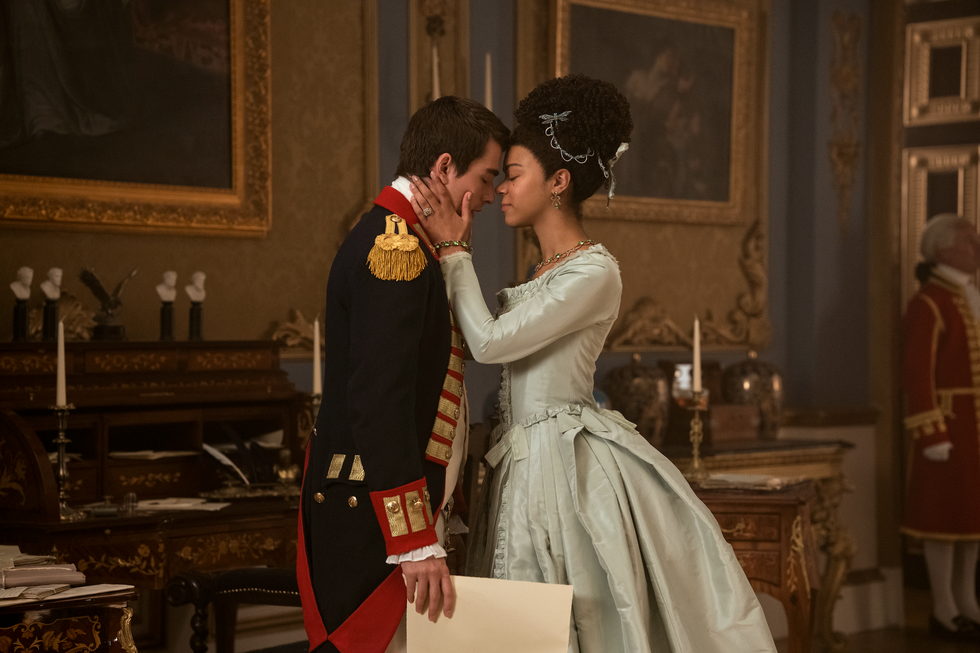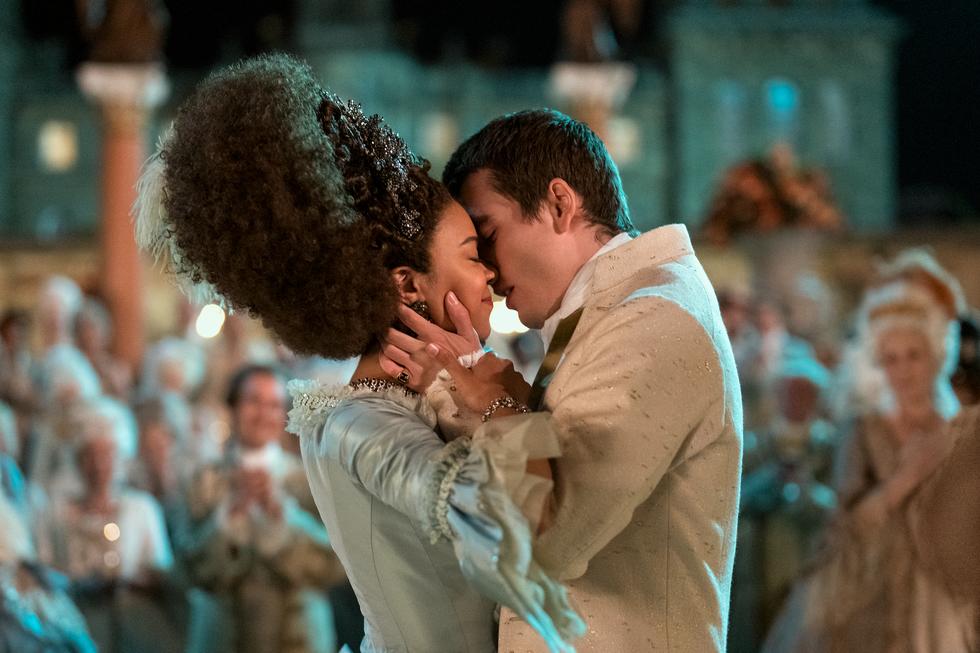Spoilers below for the entirety of Queen Charlotte: A Bridgerton Story.
“Are there any signs?”
These words, spoken by Princess Augusta (Michelle Fairley) to her son, King George (Corey Mylchreest), upon the birth of his own son in the finale of Netflix’s Queen Charlotte, are intended to sound familiar. Not everyone who binges the elegant Bridgerton spin-off will have heard them spoken before, but enough will recognize the weight of their implication. These words are part of a larger question Augusta is asking, not only about her grandson’s health, or even his fitness to rule, but about the path he will walk in life. Will he be normal? Will he be accepted? Will he have enough—be enough—to earn the status of the fully human?
This uneasiness is a frequent refrain in the lives of those with mental illness, and especially in those who’ve witnessed its effects on their loved ones. How are they doing today? Can you keep an eye on them? Did they take their meds? Did you? How are you feeling? Are there any signs?
In Queen Charlotte, King George is “mad.” We know this both from the context of the show and from history: The real-life King George III, who lost the American colonies, has carried the legacy as the “mad king” ever since. He was deemed unfit to rule in the final decade of his life, and so he passed the crown on to his son, George Augustus Frederick, the Prince Regent, beginning the so-called Regency era in 1811. This son then became king after George III’s death in 1820.
Even centuries later, George’s exact diagnosis remains unclear, if an enduring source of fascination. In the 1960s, a mother-and-son psychiatrist pair claimed the king had a genetic blood disorder known as acute porphyria, which affects the nervous system, and the theory went on to garner what researcher Timothy Peters would later claim in a 2011 issue of Clinical Medicine was “unwarranted support.” More recent research argues against the porphyria hypothesis. Peter Garrard, a researcher at St. George’s, University of London who studied the late king’s illness, told the BBC in 2013 that the porphyria theory “is completely dead in the water” and that George endured “a psychiatric illness.”
The most likely explanation for George’s so-called “madness,” then, is some form of bipolar disorder, of which the king experienced perhaps four or five episodes, per Clinical Medicine. During these periods, his behavior was marked by “agitation, rambling incoherent speech, and episodes of violence and sexual impropriety,” according to a paper published in PLOS One by Garrard, Peters, and their co-researchers Vassiliki Rentoumi and Jonathan Conlin.
A precise diagnosis is not explored in Queen Charlotte, nor does it particularly matter in the context of the story. What matters was (and is) the perception of George as “mad,” and what was to be done about it.
When Princess Augusta asks George if her newborn grandson is showing “signs,” George replies with a question to which he already knows the answer: “Of what, Mother?” She feigns innocence: “I am only asking.”
She is not only asking. She is orchestrating a strategy. She is responsible, however unintentionally, for the damage inflicted on her son by the doctor she enlisted (Guy Henry). This Doctor Monro’s violent techniques included—among other creative tortures—dunking George’s head repeatedly into ice-cold water, slapping him, starving him of nutrients, and leeching him. As the audience, we watch enough of these moments that they only narrowly avoid the territory of trauma porn, which would imply such actions were grotesque but necessary for George to become worthy of his new bride.
The limited series escapes this fate by an inch, largely in its meta-criticism of both Monro and Augusta as characters. Monro is an obvious maniac, but the more intriguing aspect of his dark personality is not the ominous way in which she shaves his liege’s face, but in the control he clearly loves exerting over the monarch. “In here, you are just another animal in a cage, and just like an animal, I will break you,” he tells George during one of these anguished sequences. Augusta never comes out and says as much, and it’s understood she’d never approve of Monro’s methods were she to learn of their depravity. But her desire to observe, subdue, and—ideally—control her son lurks beneath every one of her interactions, with him and with others in his court. Her power is tethered to his. Are there any signs?
In contrast, there is Queen Charlotte (India Amarteifio) herself, who addresses her husband’s “madness”—once she finally learns of it in later episodes—with a sort of foolhardy determination. She shuttles him away from Monro and leaves him to his farming and his observatory as she prepares for the delivery of their first child. When George’s servant, Reynolds (Freddie Dennis), informs her that, “His Majesty has good days and down days,” she is adamant that this is no longer true. “He did,” she replies. “Now that I am here, his days are good. All he needed was a routine, and his wife, and to get rid of that dreadful doctor. He is well.”
There are, then, two separate ways in which Queen Charlotte addresses the myth of what I’ll call the “love cure,” which determines that enough care and concern and “only asking” and unflinching devotion can strip a person of their mental illness—or, at least, its obvious manifestations. As Agatha Danbury (Adjoa Andoh) tells Violet Bridgerton (Ruth Gemmell) in episode 5, “What matters madness when true love flourishes?” This is an ideology I’ve come up against time and again. I have tried desperately to love someone enough, to protect them enough, that their obsessive episodes might not come between them and a “normal” existence. And I have had to resist, in my own life, the lure of that same false prophecy: that, for example, my husband can adore me so completely that the diagnosis I received a few years ago will simply cease to apply.
I, like George, do not need to get into the specifics of these personal concerns to make my argument. What matters is that I, as is the case for many watching Queen Charlotte, recognize the long tail of “madness,” and wilted at the thought the show might succumb to a comforting, persistent, but inaccurate platitude. Those who most often indulge in this platitude are the ones, like Augusta and Monro and Charlotte, who exist on the perimeters of the mental illness. They do not, perhaps, have it themselves, but its presence impacts their lives. I am and have been one of these people. We want to believe we have control. We want to believe we can do something to “save” our loved ones, or to blame someone, something, anything, should the saving prove futile. But love—even in its most genuine, heartfelt, all-consuming form—does not cure mental illness. Sometimes it does not even change mental illness. There is no universal truth about mental illness, but the closest might be this: Mental illness is persistent. It is more often adjusted than eclipsed, and even the latter outcome warrants skepticism, not just because its verbiage belies the implicit heroism of “beating” a disease.
I was thankful, then, when Queen Charlotte did not give the love cure approval sans interrogation. In the show’s excellent finale episode, Charlotte discovers her husband lying prone beneath their bed, hiding after an embarrassing display in which he experienced a panic attack, rendering him incapable of delivering a speech before Parliament. All of Charlotte’s affirmations that she is the solution to her husband’s problems dissolve when she witnesses him in this state. He, finally, tells her the truth. “There is no better,” he says. “There is no cure. This is who I am. I will be here sometimes, and sometimes I will be…” He trails off. “You can leave me. I would understand, and I would let you go.”
Instead, she reminds him, “Together, we are whole. I love you. It is enough.”
The wording here is essential. This time, Charlotte does not indicate that loving George will transform him. Instead, she determines she does not need him to be transformed in order to consider him whole. “Half king, half farmer, but always just George,” she says. “That is all you need to be.”
“What matters madness when true love flourishes?” How this question rankles. Of course it matters. It matters so much it’s traumatizing. “Madness” matters more than anyone living with a mental illness cares for it to. It can permeate even the most sacred of spaces, the most tender of relationships, the most joyful of memories. It stigmatizes and separates. We watch this play out with both Charlotte and George, in the ways Charlotte must isolate herself as they grow older and George is forced to sacrifice most of his royal duties. Their love, however true, cannot exclude them from the pain that accompanies it. These realities cannot be parsed. Of course love is essential. Love can (and often does) do extraordinary miracles. But love is not about “fixing” someone, for their benefit or for your own. Love is not a cure, but it can be a constant.
And, so, Queen Charlotte does not ultimately treat George’s “madness” as a devil to be exorcised, nor as a “special” talent to be heralded, but as the appendage of a person. George, in all his complexity, is just George.
I do not blame Augusta for asking, “Are there any signs?” I can no more judge her than I can myself. I, too, also studied and obsessed and mitigated and sought control in my long, drawn-out hunt for a love cure that erases every so-called “sign.” But I take enormous comfort in the fact that, ultimately, a show like Queen Charlotte understands these inquiries are too often misguided. The real question is not always, “Are there any signs?” or, “Do they matter?” There are. They do. The question should be: “How often can you see and endure these signs, and then see the human better?”
Culture Writer
Lauren Puckett-Pope is a staff culture writer at ELLE, where she primarily covers film, television and books. She was previously an associate editor at ELLE.



